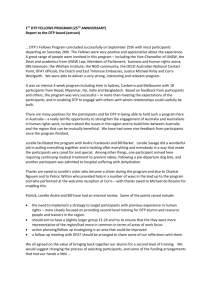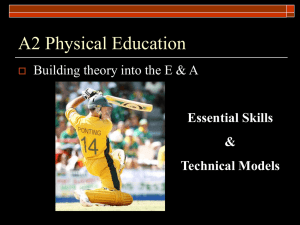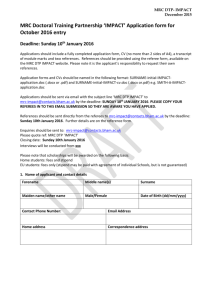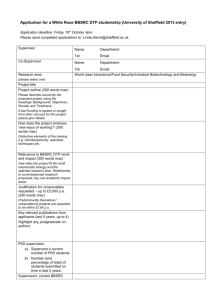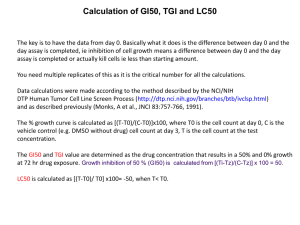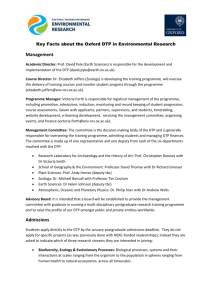final-ln
advertisement
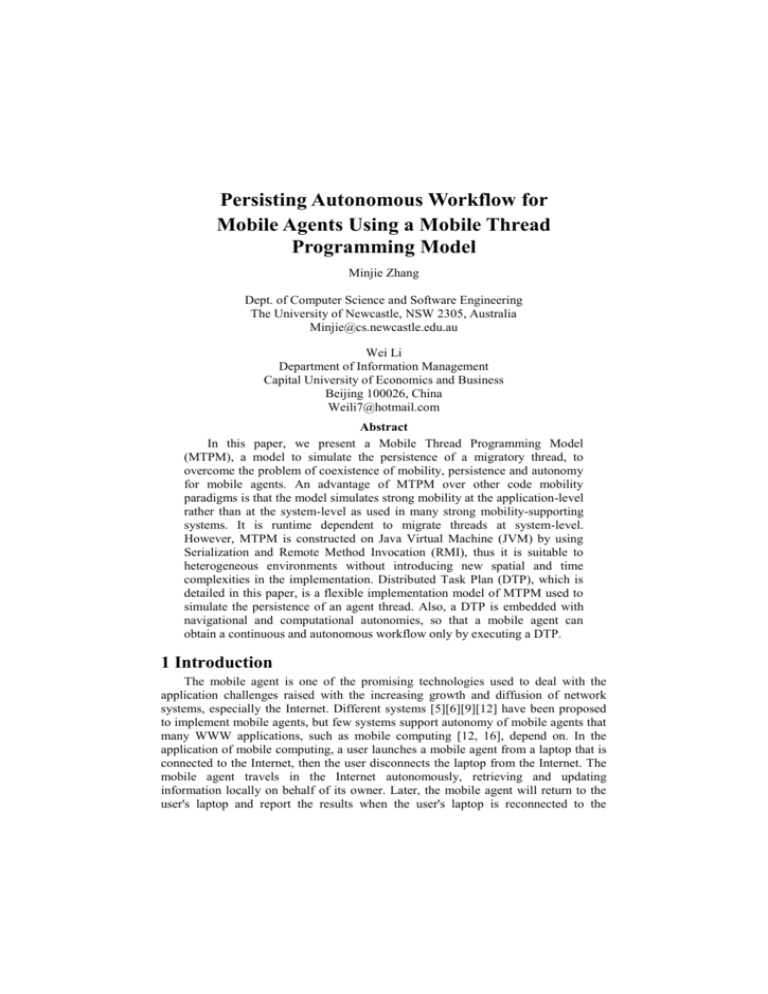
Persisting Autonomous Workflow for
Mobile Agents Using a Mobile Thread
Programming Model
Minjie Zhang
Dept. of Computer Science and Software Engineering
The University of Newcastle, NSW 2305, Australia
Minjie@cs.newcastle.edu.au
Wei Li
Department of Information Management
Capital University of Economics and Business
Beijing 100026, China
Weili7@hotmail.com
Abstract
In this paper, we present a Mobile Thread Programming Model
(MTPM), a model to simulate the persistence of a migratory thread, to
overcome the problem of coexistence of mobility, persistence and autonomy
for mobile agents. An advantage of MTPM over other code mobility
paradigms is that the model simulates strong mobility at the application-level
rather than at the system-level as used in many strong mobility-supporting
systems. It is runtime dependent to migrate threads at system-level.
However, MTPM is constructed on Java Virtual Machine (JVM) by using
Serialization and Remote Method Invocation (RMI), thus it is suitable to
heterogeneous environments without introducing new spatial and time
complexities in the implementation. Distributed Task Plan (DTP), which is
detailed in this paper, is a flexible implementation model of MTPM used to
simulate the persistence of an agent thread. Also, a DTP is embedded with
navigational and computational autonomies, so that a mobile agent can
obtain a continuous and autonomous workflow only by executing a DTP.
1 Introduction
The mobile agent is one of the promising technologies used to deal with the
application challenges raised with the increasing growth and diffusion of network
systems, especially the Internet. Different systems [5][6][9][12] have been proposed
to implement mobile agents, but few systems support autonomy of mobile agents that
many WWW applications, such as mobile computing [12, 16], depend on. In the
application of mobile computing, a user launches a mobile agent from a laptop that is
connected to the Internet, then the user disconnects the laptop from the Internet. The
mobile agent travels in the Internet autonomously, retrieving and updating
information locally on behalf of its owner. Later, the mobile agent will return to the
user's laptop and report the results when the user's laptop is reconnected to the
Internet. Mobile agents should have "intelligence" of self-contained navigation and
computation, which give mobile agents the adaptation powers to the dynamic and
heterogeneous networks, because in most cases mobile agents can not interact with
their owners.
There are two kinds of features that must be satisfied by mobile agents in the
context of autonomy. They are the persistence of an agent thread and the selfcontainment in navigation and computation. Unfortunately, the elaborated coexistence
of mobility, persistence and autonomy are difficult and not adequately modeled and
supported by most existing mobile agent systems. This paper proposes a Mobile
Thread Programming Model (MTPM) with its implementation model, Distributed
Task Plan (DTP) [11]. MTPM is an application-level model to simulate the
persistence of threads after an agent migration. MTPM deals with heterogeneity of
agents' execution environments by JVM without introducing any new spatial and time
complexities in the implementation. DTP is a flexible implementation model of
MTPM. DTP complies with the MTPM's programming paradigm and is embedded
with navigational and computational autonomies. An agent plans its DTP when the
agent is generated. When a DTP is executed by a mobile agent, the DTP generates
continuous and autonomous workflows for the agent.
This paper is organized as follows. In Section 2, we analyze features of agent
mobility, and sum up the limitations of widely studied technologies, which are
unsuitable for generating persistent and autonomous workflows for mobile agents. In
Section 3, we propose a new model, MTPM, for agent migration and prove its
correctness. In Section 4, we outline the foundation of the MTPM implementation by
using technologies of Object Serialization [15] and Remote Method Invocation (RMI)
[16]. In Section 5, we describe an implementation model, DTP, of MTPM. A DTP
plans distributed tasks for mobile agents. The execution of a DTP generates
continuous workflows with navigational and computational autonomies for mobile
agents. In Section 6, we compare the effectiveness of MTPM to typically related
works by analyzing many factors. Finally we present our conclusions and directions
of future researches in Section 7.
2 Problem Description on Agent Migration Mechanisms
Generally speaking, there are two kinds of agent migration mechanisms to be
distinguished. They are often called weak and strong mobility [3]. Weak mobility
permits an agent to migrate only with its codes and values of variables. After
migration, the agent is restarted and values of its variables are restored. But the
agents' execution starts from the beginning or from a special method rather than the
stop point before agent migration. Weak mobility does not support the persistence of
agent threads. Many mobile agent systems only support weak mobility of agents.
They are Odyssey [5], Voyager [12], Java-To-Go [11], Aglets [9], Facile [17],
Tocoma [8], Mole and Grasshopper [7] etc. Strong mobility permits the agent to
migrate not only with codes but also with the whole state of thread execution. After
migration an agent is restarted its execution exactly from the point where it was
suspended before migration, so strong mobility supports the persistence of agent
threads. Some mobile agent systems support strong mobility of agents. They are
Telescript, Agent Tcl [6], Ara [13] and Sumatra [1] etc.
In many weak mobility supporting systems, the mechanism behind the weak
mobility is to program a mobile agent kernel with many different methods that will be
executed by the agent at different network nodes. When an agent executes the mobile
primitives for migration, the agent must explicitly provide a destination address and a
method to be executed at that destination. On the other hand, strong mobility requires
that the mobile agent server transparently and randomly captures the thread's
execution mapping of any agent, transports the captured mapping and restores the
transported mapping after agent migration.
The state of the art is that mobile agent systems with weak mobility have wide
platform acceptances because they are often constructed by popular languages such as
Java, but they suffer from the following limitations for programming autonomous
mobile agents.
1. Few procedures or primitives are provided for supporting agents' autonomies
in the mobility and the computation. Although it is possible, it is difficult to program
a mobile agent with desirable autonomies.
2. Their programming paradigms are not for workflow models [2], so they
provide no inherent supporting for designing an autonomous agent. It is difficult for
them to generate continuous workflows.
3. A mobile agent and its distributed tasks are programmed in the same program
unit (or class), so both reusability and flexibility are lost. A mobile agent can only
execute a distributed task without revising its codes.
Persistence is fundamental for the next-generation of agent-based applications
[14]. Although current mobile agent systems with strong mobility are easy to expend
for supporting autonomies for mobile agents, they are often constructed with special
languages or they modify popular language's specification such as JVM for
facilitating the capture of an agent's execution state. These prevent them from being
widely accepted and used to build agent-based applications in multiple platforms. An
evident example is that General Magic rewrites its mobile agent system, Telescript,
into Odyssey by using Java, in order to be widely accepted. In addition, because
threads are strongly bound to the runtime system, it is difficult for strong mobility at
system-level implementation to deal with heterogeneous environments in which
mobile agents roam. Also it is inefficient to implement persistence at system-level by
capturing, transporting and restoring the execution state of the agent thread because
an agent thread has huge information of execution stacks and heaps. It is reported in
[4] that strong mobility is implemented at language-level, but [4] introduces extra
time and space overhead at the same time.
In the context of autonomy, agents must have two features, the persistence of
agent thread and the self-containment in navigation and computation. Limitations of
current agent migration technologies have made us design a new mobile agent system
Mobile Agent Template (MAT) [10] by Java for supporting autonomous mobile
agents. In MAT, we program mobile agents with MTPM paradigm. We pursue
coexistence of persistence, mobility and autonomy with MTPM. Fully transparent
migration is not a necessity. MTPM simulates strong mobility at an application-level
using a lightweight implementation on JVM, so it is suitable for programming mobile
agents to heterogeneous environments without introducing new spatial and time
complexities in the implementation. When it is generated, a mobile agent plans its
DTP that is the implementation model of MTPM. The execution of a DTP generates
continuous and autonomous workflows for mobile agents. MTPM does not need any
modification of JVM, and it uses two new mechanisms, Serialization and RMI,
provided by JVM.
3 Mobile Thread Programming Model
3.1 Persistence simulation of a mobile agent's thread
In this section, we introduce MTPM, which is a model to simulate the persistence
of migratory threads for mobile agents at application-level. This model depends on
Serialization and RMI mechanisms of JVM. Writing an object state into a serialized
form is sufficient to reconstruct the object as it is read. Thus, writing and reading
objects are called object serialization and deserialization. A thread is ultimately code
and data, and we suspect that state can always be represented by data. Object
serialization and deserialization are essential and enough to simulate a persistent state
of an agent thread based on the following proposed theory.
Definition 1: The serialization operation on an object Obj is denoted as Ser(Obj), and
the deserialization operation on a serialized object Ser(Obj) is denoted as
Deser(Ser(Obj)).
Agent
Zone A
Zone B
Zone C
Zone C
Agent
Server
Agent
pubilc class Agent {
public Integer entry_point;
………….…….
onDispatch() {
…………. }
onArrival() {
…………. }
run()
{
………….
switch(entry_point)
case 1:
………….
AgentMobileTo(Destination, 2);
case 2:
………… } }
AgentMobileTo(Destination, agent);
agent.onDispatch();
TransferTo(Destination, agent);
Local Host
public class Agent {
pubilc Integer entry_point;
………………
onDispatch() {
………..
}
onArrival() {
………..
}
run()
{
………….
switch(entry_point)
case1:
………..
case 2:
…………
Agent
Server
}}
AgentTansferIn(agent);
agent.onArrival();
new Thread(agent).start();
Remote Host
Fig.1 The migration simulation of agent's thread by MTPM
In order to simulate the state persistence of an agent's thread, the following three
methods must be provided to a mobile agent.
onDispatch(): This method is called just before an agent migration. It performs
serialization operations on every non-transient object Obj in Zone A (see Fig. 1) of an
agent, i.e. for each Obj in Zone A of an agent, perform Ser(Obj).
onArrival(): This method is called just after a serialized agent object is
transported to the destination by RMI. Contrary to onDispatch(), it performs
deserialization operations on every serialized object Ser(Obj) of an agent, i.e. for each
serialized object Ser(Obj) of an agent, perform Deser(Ser(Obj)).
run(): This method is the running method of an agent thread. This method will be
called when an agent thread is generated at the home machine or restored at a remote
network node. In order to support the simulation of the state persistence of an agent's
thread, the run() method should use the switch entry_point paradigm as shown in
Fig.1. The run() method consists of switch-case statements. Every mobile primitive is
the last statement in a case branch, and a mobile primitive sets a new entry of the
run() method that will be recalled at the next destination from the new entry.
Having defined the above three methods, the migration simulation of an agent
thread is also graphically illustrated in Fig.1. When an agent executes the mobile
primitive such as AgnetMobileTo(Destination, 2), the mobile primitive sets a new
entry entry_point as 2 and calls the method AgentMobileTo(Destination, this) of
current Agent Server. The Agent Server calls back the agent's method onDispatch() so
as to give an opportunity to the agent to serialize its objects. Then, current Agent
Server calls its method TransferTo(Destination, agent) to transport the agent object to
the Agent Server at the destination. In fact, current Agent Server calls the remote
method TransferIn(agent) of the Agent Server at the destination by RMI. RMI
permits to transfer an object reference graph as a parameter to a remote method, so in
fact, current Agent Server transports the agent in the form of a serialized object to the
destination. The first thing of TransferIn is to call back the agent's method onArrival()
to deserialize the agent's serialized objects, then generate a new thread to execute the
agent. The agent will be executed from the statement case 2 when its method run() is
recalled.
3.2 Proof of MTPM's correctness
Generally, objects that are generated by an agent are in Zone A, Zone B or Zone
C. Objects in Zone A can be persisted by Java Serialization because they are classlevel variables. However, objects in Zone B or Zone C can not be persisted by Java
Serialization because local variables of a method are located in the method call stack
of JVM and can not be reached by Java Serialization. But according to Objectoriented paradigm, any object that is generated in a method is local and transient, so
any persistent information of an agent does not depend on objects in Zone B or Zone
C. In addition, any object in Zone B, which may be used in following case branches,
is regenerated when the method run() is recalled; Objects in Zone C do not depend on
each other if they are in different case branches. Summarizing the above features in
the proposed paradigm of agent design, we have the following theorem, which proves
that the persistence of agent thread can be simulated by MTPM.
Axiom 1: For any object Obj, Obj is equal to Deser(Ser(Obj)).
Axiom 2: The execution state of an agent's thread is only determined by both the
states of the agent's objects in Zone A and the execution point of the method run() in
MTPM paradigm.
Theorem 1: The persistence of an agent thread can be simulated by MTPM during the
agent migration.
Proof: We must define entry_point as a member variable of a mobile agent class
because Serialization can not capture any local variable of a method. Suppose an
agent executes a mobile primitive AgentMobileTo(Destination, k), which is the
number k-1 statement of the agent's method run(), then the execution stop-point k is
stored in the object entry_point of the agent. Also suppose the agent has valid objects
Obj1, Obj2,……, Objn (of course including the object entry_point) in Zone A, then the
method onDispatch() of the agent will serialize all the objects, i.e. performs Ser(Obj1),
Ser(Obj2),……, Ser(Objn) when the method is called just after AgentMobileTo. When
the agent object is transported to the destination, its method onArrival() is called. The
method onArrival() deserializes all the serialized objects, i.e. performs
Deser(Ser(Obj1)), Deser(Ser(Obj2)),……, Deser(Ser(Objn)). From Axiom 1, Obji is
equal to Deser(Ser(Obji), where i belongs to {1, 2,……n}, so states of all the objects in
Zone A of the agent (of course including object entry_point) are persistent. …..…(a)
When the agent is restarted at the destination, its thread's execution method,
run(), is called. All the objects in Zone B will be regenerated and the method run()
will execute from the case statement that is determined by object entry_point.
Because the object entry_piont is k, the stopped execution point is restored from the
statement k after the agent migration has been completed. ………………………(b)
From (a) and (b), the execution state of the agent's thread is persistent after the
agent migration according to Axiom 2.
4 Foundation of MTPM Implementation
Our agents need persistence, which is the ability of an object to record its
execution state so the state can be reproduced in other environments. With the release
of Java1.1, the Java community has gained access to a wide variety of features.
Important features, which contribute to the implementation of MTPM, are object
Serialization and RMI. Combinations of these make it possible to simulate persistence
of an agent's thread with object persistence.
Object Serialization provides a program with the ability to read or write a whole
object to and from a raw byte stream. It allows objects and primitives to be encoded
into a byte stream suitable for streaming to some type of network or to a file-system,
or more generally, to a transmission medium or storage facility. The real power of
object Serialization is the ability of programs to easily read and write entire objects
and primitive data types, without converting to/from raw bytes or parsing clumsy text
data. Object Serialization has taken a step in the direction of being able to store
objects instead of reading and writing their state in some foreign and possibly
unfriendly format. In order to be persistent, the class definition of a mobile agent
should implement the Serializable interface. We can customize serialization for an
agent by rewriting and providing two methods writeObject and readObject to the
agent. The two methods in agent implementation are functional equivalents to
onDispatch() and onArrival() in MTPM. The process of serializing an object involves
traversing the graph created by each object's references to other objects and
primitives. So all the objects including agent object and objects that can be reachable
by references of the agent are preserved during agent Serialization.
RMI enables a program running on a client computer to make method calls on an
object located on a remote server machine. Object-oriented design requires that every
task be executed by the object most appropriate to that task. RMI takes this concept
one step further by allowing a task to be performed on the machine most appropriate
to the task. A client can invoke the methods of a remote object with the same syntax
that it uses to invoke methods on a local object. RMI has several advantages over
traditional Remote Procedure Call (PRC). RMI can pass full objects as arguments and
return values. This means that we can pass complex types such as an agent object as a
single argument without extra converting codes. Passing objects lets us use full power
of object-oriented technology in agent migration. When passing an object as an
argument, RMI moves class implementations of the object at the same time. At this
point, RMI moves behavior from a client to a server or a server to a client, so we can
benefit from fully object-oriented patterns for agent design. In addition, RMI uses
built-in Java security mechanisms that allow the agent system to be safe when moving
agents. Customized security mechanisms are easily integrated into agent system with
RMI security Model such as specifying Security Manager in Java 1.1 or Policy File in
Java 1.2. With RMI we can write a mobile agent system in the simplest form like this:
import java.rmi.*;
public interface AgentServer extends Remote {
void
TransferTo (String Destination, Agent agent)
throws RemoteException, InvalidAgentException;
void
TransferIn(Agent agent)
throws RemoteException, InvalidAgentException;
AgentServer getRemoteAgentServer(String Destination)
throws RemoteException, AgentServerNotFoundException;
void
registerAgentServer(String agentServerName)
throws RemoteException, AgentNameInvalidException;
void
unregisterAgentServer(String agentServerName)
throws RemoteException, EntryNotFoundException;
void
createAgent(String agentClassName, Class parameterTypes[], Object initargs[])
throws RemoteException, InvalidAgentException;
}
import java.io.Serializable;
pulblic interface Agent extends Serializable {
void onDispatch();
void onArrival();
void run(); }
In an agent system, an Agent Server is a remote object to which other Agent
Servers in the system have references. Transporting an agent would be a matter of
creating a class that implemented the Agent interface, finding a server, and invoking
its TransferIn method with the agent object as an argument. The implementation for
the agent would be transported to the server and run there. We don not have to write
the two methods of onDispatch() and onArrival() if we would like to perform default
serialization for a mobile agent by RMI. After deserializing the agent, the
TransferIn() method will start up a new thread for the agent and invoke its run()
method.
5 DTP: a Flexible Implementation of MTPM
In fact, in the implementation of MTPM, we do not program all the tasks to be
executed by an agent in its run() method because this kind of design can not support
flexibility, reusability and workflow mode. Instead, we use a flexible implementation,
Distributed Task Plan (DTP), to support continuous and autonomous workflows for
mobile agents.
5.1 Architecture of DTP
In this section, we introduce Distributed Task Plan, which is a flexible
implementation of MTPM for generating continuous and autonomous workflows for
mobile agents. In MAT, we define two kinds of autonomies for mobile agents.
Definition2: Mobile autonomy is the capability of self-navigation of mobile agents
through the underlying network.
Definition 3: Computational autonomy is the capability of self-containment of mobile
agents in computational functions for the accomplishment of a distributed task.
In order to obtain desirable autonomies for mobile agents, firstly, we provide
enough programming components called autonomous primitives, which are used to
construct a DTP and further to provide mobile agents with autonomies in the
navigation and the computation. Four kinds of autonomous primitives are defined in
MAT for DTP designing.
1. Mobile primitives define the mobility of an agent. A mobile agent can merely
transport itself to the next destination from the current network node by calling a
simple migration primitive, or clone and transport each of its duplicates to different
destinations by calling a multiple migration primitive.
2. Computational primitives define invocations of computational resources. A
computational primitive specifies where to find the current computational procedure,
how to load it and how to execute it. By using the computational primitives, a mobile
agent realizes that (a) the current computational procedure is carried by the agent or is
resident at the visiting node; (b) the procedure should be started in a different process
or loaded into its own process; and (c) how to run the computational procedure such
as synchronously or asynchronously.
3. Solution synthesis primitives define the combination of multiple solutions
from different mobile agents. The solution synthesis is needed when a task is divided
into several subtasks and executed by different mobile agents concurrently. It is
highly efficient to divide a task into several subtasks and to assign these subtasks to
different mobile agents for the executions when the task can be executed concurrently
and multiple resources are available.
4. Control primitives define the execution flow of mobile primitives,
computational primitives and solution synthesis primitives. Enough control structures
in control primitives are needed to efficiently coordinate the executions of all the
above three primitives.
Having defined primitives, we provide reasonable model to design DTP, which
depicts distributed tasks for mobile agents by advantages of those pre-defined
autonomous primitives. Normally, a DTP is composed of all the four kinds of
autonomous primitives.
Definition 4: A Distributed Task Plan (DTP) is a static description of a distributed
task, which is to be executed by a mobile agent.
A DTP consists of primitives, which are arranged into two lists. A list, which we
prefer to call a control queue (CQ), only contains control primitives, and the other list,
which we prefer to call a reusable primitive list (RPL), contains any primitives except
control primitives. The architecture of a DTP is graphically illustrated in Fig. 2
(concrete meanings of primitives of Fig. 2 are defined in [11] ).
The order that control
primitives enter CQ
The order that control
primitives are executed
Control Queue
Reusable Primitive List
SimpleInvocation
SimpleMobile
EventMonitor
ExterExecution
SimpleInvocation
MultiMobile
ConditionBranch
IntraInvocation
ConditionBranch
ExterExecution
The order that reusable
primitives enter RPL
SimpleInvocation
FullSynthesis
The order, which reusable
primitives are executed, is
determined only by references
Fig.2 The architecture of DTP
5.2 Continuous and autonomous workflows of a DTP
When being generated, a mobile agent plans its own DTP for the execution of a
distributed task satisfying a user's requirements. The planning includes Objective
Matching, Primitive Selection and DTP Generation by using the user's requirements,
network state information and task features. A mobile agent can also replan its DTP
when current DTP fails during the execution. The planning of a DTP is detailed in
[11].
Definition 5: An execution of a DTP by a mobile agent in a dynamic network
environment is a continuous and autonomous workflow of the mobile agent.
DTP.run()
agent
DTP
CP.run()
CP=getNextControlPrimitive()
CP==null
agent
mobile
resource
retrieval
event
monitor
result
combination
EP.run()
EP
exit
execution
CP
EP=getReferenceFromRPL()
Fig. 3 The continuous & autonomous workflow generating by DTP
A mobile agent has a reference to its DTP, and a DTP has reference to a CQ. All
the objects, from the agent itself, DTP to autonomous primitives, have a run()
method. Every object's run() method just calls the run() method of another object to
which the former has a reference. The autonomous workflow of a mobile agent is
generated when the mobile agent executes its DTP by calling its run() method as
shown in Fig.3.
The order of primitives in a CQ is important. The control primitives in a CQ are
executed sequentially. A control primitive in a CQ has one or more references to
primitives in a RPL corresponding to which type the control primitive is. A reference
of a control primitive in a CQ depicts a possible invocation to a primitive in a RPL.
The order of primitives in a RPL is not important because the invocations to them are
determined only by references of control primitives in a CQ. A RPL is just a
repository of autonomous primitives that a mobile agent may need to execute when
transporting in underlying networks. So a mobile agent only executes control
primitives in a CQ one by one, then further executes primitives in a RPL. An
execution of a DTP is a continuous and autonomous workflow of a mobile agent.
Constructing a complex workflow by using DTP provides a mobile agent with
autonomy, flexibility and reusability in distributed applications.
6 Related Work
To our knowledge, providing transparent migration for agents at language-level
is done in [4][18], and providing mobility, persistence and autonomy for agents at the
same time is done in very few models besides our model. To capture the state of an
agent for fully transparent migration, [4] has developed a preprocessor that
instruments the programmers' Java codes by adding codes. Those added codes do the
actual state capturing, and reestablish the state on restart at the target machine. [4]
does this instrumentation by parsing the original program code using a Java based
parser. In fact, what is done by [4] is a mechanical transformation of codes written for
transparent migration into codes written for non-transparent migration. [4] has to deal
with complex problems, such as saving and rebuilding local variables, objects and the
method call stack, but to leave thread synchronization to programmers. In [18], a selfmigration computation is separated into two layers. The computational layer consists
of an arbitrary collection of functions distributed throughout the system, and the
coordination layer deals primarily with the locations at which various functions are to
be executed and the communication among functions. In [18], the programmers'
original script must satisfy the following three conditions for facilitating the
transformation of the original script into a pseudo code script that supports transparent
migration: 1. The original script consists of only function calls; 2. All functions are
numbered and each knows its possible successors; and 3. Any statement that may
cause a context switch may execute only as the last statement of a function. Tab.1
compares some important features of [4], [18] and MTPM.
MTPM provides a lightweight mechanism that is functionally equivalent to
transparent migration. MTPM does not introduce any extra time and space overhead
as in [4], but only has the restriction as the third one of [18]. MTPM generates
persistent and autonomous workflows at minimum time and space costs, and
restrictions in programming paradigm.
Features
[4]
[18]
MTPM
Location of
Mobile Instruction
anywhere
restricted(more)
restricted(less)
Transparent Migration
yes
yes
Preprocessing
Extra Time Overhead
yes
no
functionally
equivalent
no
4%~19%
none
none
3.4~4.7(times)
none
none
none
yes
less
no
more
yes
Blow-up Factor
of Bytecode
Autonomy
Platform Independence
Tab.1 Comparison of [4], [18] and MTPM
7 Conclusion
Many WWW applications such as mobile computing depend on autonomies of
mobile agents. The threads of mobile agents should be continuous and autonomous
workflows; i.e. the persistence and autonomy of thread of an agent are two basic
features of an autonomous mobile agent. It is difficult, inefficient and runtime
dependent to support thread persistence at system-level. In the context of autonomy
and heterogeneity, the widely used code migration mechanisms provide no inherent
support for the design of mobile agents. Thus, we have proposed and proved a model,
MTPM that is suitable for designing a workflow of mobile agents. MTPM simulates
the state persistence of thread of an agent by Serialization and RMI without
introducing any new spatial complexity in the implementation.
DTP is a flexible implementation of MTPM. DTP complies with the
programming paradigm defined by MTPM, so a DTP generates a continuous
workflow when a mobile agent executes it. Because a DTP is composed of
autonomous primitives, a DTP embeds some degree of autonomy or "intelligence"
into mobile agents. Using a DTP, navigational and computational autonomies are
carried by mobile agents as they transport through the underlying computational
networks. A mobile agent can freely transport and use many different computational
resources in a heterogeneous network by executing autonomous primitives in a DTP
without interaction with its owner.
For supporting the coexistence of persistence, mobility and autonomy, we have
presented a basic framework, MTPM, with its implementation model, DTP, in this
paper. Our future work will focus on investigating the suitability of MTPM and DTP
in WWW applications, such as Internet information retrieval, electronic commerce
and Computer Support Cooperative Work (CSCW). From feedback of the
investigations, we can find problems in MTPM and DTP, and make improvements in
both the model and its implementation.
References
[1] A. Acharya, M. Ranganathan, and J. Saltz, Sumatra: A Language for resourceaware mobile Programs, In Mobile Object System: Towards the Programmable
Internet, Lecture Notes in Computer Science, No. 1222, Springer-Verlag, pp. 111130, Linz, Austria, July 1996.
[2] Ting Cai, Peter Gloor, and Saurab Nog, Dartflow: A workflow management
system on the Web using transportable agents, Technical Report TR96-283,
Department of Computer Science, Dartmouth College, Hanover, N.H., 1996.
[3] A. Fuggetta, G. Picco, and G. Vigna, Understanding Code Mobility, IEEE
Transactions on Software Engineering, Vol. 24, No. 5, pp. 342-361, May 1998
[4] Stefan Funfrocken, Transparent Migration of Java-Based Mobile Agents:
Capturing and Reestablishing the State of Java Programs, In Proceedings of the
Second International Workshop on Mobile Agents, Lecture Notes in Computer
Science, No. 1477, Springer-Verlag, pp. 26-37, Stuttgart, September 1998.
[5] General Magic, Introduction to the Odyssey API, available at http://www.
generalmagic.com /agents/ odysseyIntro.pdf, 1997-1998.
[6] R.Gray, Agent Tcl: A flexible and Secure mobile-agent system, In Proceedings of
Fourth Annual Tcl/Tk Workshop, Monterey, California, July 1996.
[7] IKV, Grasshopper, available at http://www.ikv.de/products/grasshopper.html,
1999.
[8] D. Johansen, R. van Renesse, and F. B. Schneider, An introduction to the
TACOMA Distributed system, Computer Science Technical Report 95-23, University
of Tromso, Norway, 1995.
[9] D. B. Lange and M. Oshima, Programming and Developing Java Mobile Agents
with Aglets, Forthcoming booking, Addsion-Wesley, 1998.
[10] Wei Li, and Minjie Zhang, Distributed Task Plan: A Model for Designing
Autonomous Mobile Agents, in the Proceedings of International Conference on
Artificial Intelligence, Las Vegas, pp. 336-342, 1999.
[11] William Li, and D. G. Messerschmitt, Java-to-go, Technical report, Dept. of
EECS, university of California, Berkeley, available http://ptolemy.eecs.berkeley.edu
/dgm/javatools/java-to-go/, 1996
[12] Object Space, Voyager Core Technology 2.0 User Guide, available at
http://www.objectspace.com/ developers/voyager/white/voyager20.pdf, 1998.
[13] H. Prine, An introduction to mobile agent programming and the Ara system, ZRI
Technical Report 1/97, Dept. of Computer Science, University of Kaiserslautern,
available at http://www.uni-kl.de/AG-Nehmer/Ara.ara.html, January 1997.
[14] M. Mira da Silva, and A. Rodrigues da Silva, Insisting on Persistent Mobile
Agent Systems, In Proceedings of the First International Workshop on Mobile
Agents, Lecture Notes in Computer Science, No. 1219, Springer-Verlag, pp. 174-185,
Berlin, April 1997.
[15] SUN, Object Serialization, available at http://java.sun.com/products/jdk/
1.2/docs/guide/serialization, 1999.
[16] SUN, Java Remote Method Invocation Specification, available at
http://java.sun.com/products/jdk/ 1.2/docs/guide/rmi/spec/rmi-title.doc.html, 1999
[17] B. Thomsen, L. Leth, and S.Prasad, Faclie Antigua Release Programming Guide,
Technical Report ECRC-93-20, European Computer Industry Research Centre,
Munich, Germany, Dec. 1993.
[18] Christian Wicke, Lubomir F. Bic, Michael B. Dillencourt, and Munehiro
Fukuda, Automatic State Capture of Self-Migrating Computations in MESSENGERS,
In Proceedings of the Second International Workshop on Mobile Agents, Lecture
Notes in Computer Science, No. 1477, Springer-Verlag, pp. 68-79, 1998.
